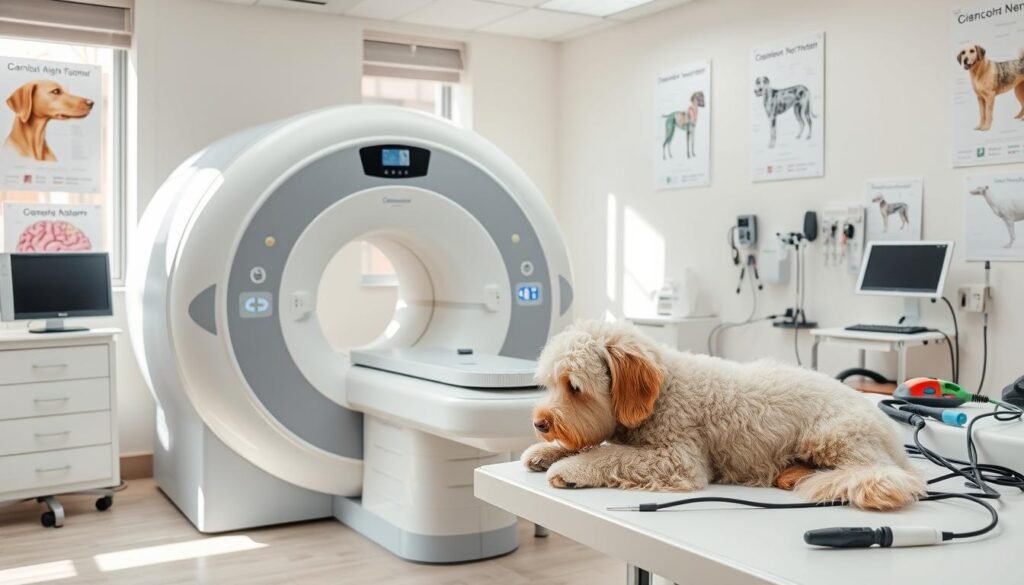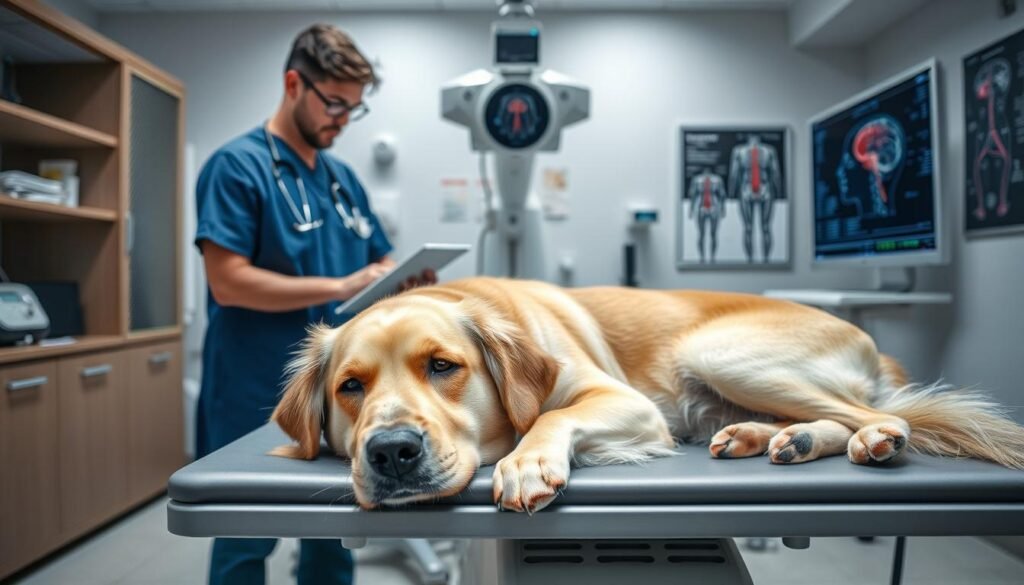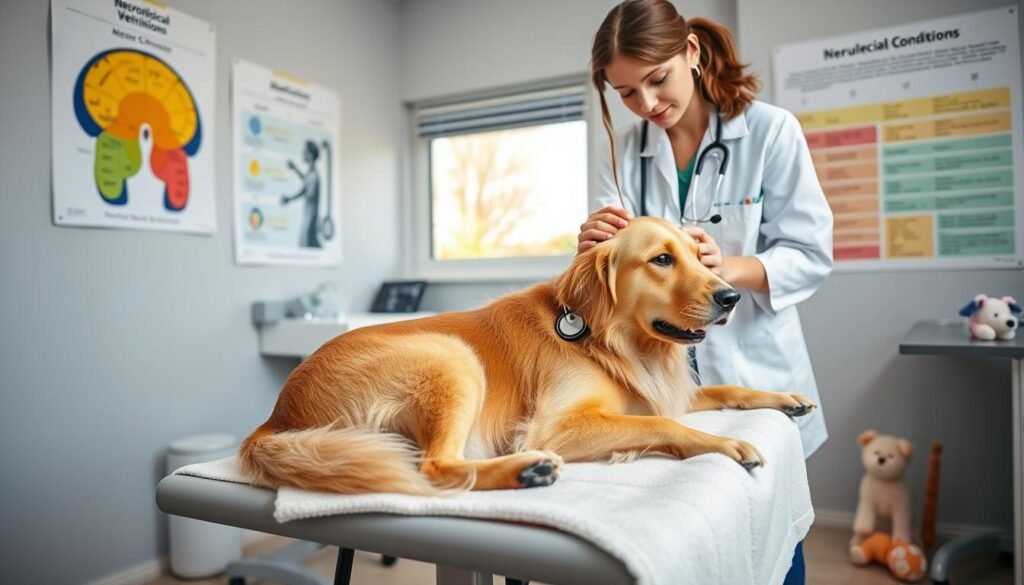Do you have any idea about Dog Neurologist Cost Without Insurance? As a pet owner, seeing your furry friend face a neurological issue can be scary. The cost of a visit to a dog neurologist without insurance can change a lot. Knowing what you might pay can help you plan and handle the costs of your dog’s care.
The place where you take your dog for neurological care can affect the price. Places like California, New York City, and South Florida usually cost more because of higher living costs and the need for top doctors.
The cost also depends on the tests your dog needs and its size. For example, MRI scans, which help see neurological problems, can cost about $5,000. But, most pet insurance covers these scans, so you might pay less if you’re insured.
What treatment your dog needs can also change the price. Things like medical care or surgery can cost more than just regular visits.
Handling the costs of your dog’s care is important. Look into pet insurance, savings, credit cards with payment plans, and charities that help with vet bills1. Some places, like the Veterinary Neurological Center in Phoenix, take CareCredit for easier payments.
Table of Contents
ToggleKey Points
- The cost of seeing a dog neurologist without insurance can vary widely, depending on factors such as location, the complexity of the condition, and the type of diagnostic tests and treatments required.
- Specialized imaging techniques like MRI scans can cost around $5,000 on average, but most pet insurance plans do cover these types of procedures.
- Neurological emergencies or complex cases that require extended testing and hospitalization may be more expensive than routine appointments.
- Exploring payment options, such as pet insurance, savings accounts, credit cards with repayment plans, and charitable organizations, can help manage the financial aspects of your dog’s neurological care.
- Some veterinary neurology centers accept CareCredit, which offers flexible financing options for pet owners.
Introduction to Veterinary Neurology
Understanding veterinary neurology can seem tough for pet owners. But knowing what veterinary neurologists do is key. These experts are trained to handle many neurological issues in dogs. They deal with problems of the brain, spinal cord, and nerves4.
What is a Veterinary Neurologist?
Veterinary neurologists are experts with extra training. They know how to read MRI and CT scans and perform complex procedures. They help dogs with brain and spinal cord issues5.
Common Neurological Conditions in Dogs
- Intervertebral disc disease
- Seizures
- Brain tumors
- Spinal cord injuries
- Neuromuscular disorders
These issues can show up in many ways, often as just one symptom. Vets use tests like “knuckling” to check if a pet’s issue is neurological. If a dog has trouble in many brain or spine areas, they might need more tests like MRI or spinal taps.
Knowing about veterinary neurologists and common dog issues helps pet owners. It prepares them to get the right care for their pets.
The Importance of Early Diagnosis and Treatment
Early diagnosis and treatment are key for dogs with neurological issues. Many conditions can get worse or become permanent if not treated. Getting your dog to a vet quickly can help them live a better life.
Early diagnosis helps vets find the cause and start the right treatment. This might include medicine, therapy, or surgery. Acting fast can really help your dog’s chances of getting better.
- Intervertebral Disc Disease (IVDD) is common in dogs like Dachshunds and French Bulldogs.
- Idiopathic epilepsy is the top cause of seizures in dogs and is genetic.
- Vestibular disease often strikes older dogs and can come from ear infections.
- Wobbler syndrome affects big breeds like Doberman Pinschers and Great Danes.
- Degenerative myelopathy is seen in older German Shepherds and causes back weakness and paralysis.
- Meningitis and other brain diseases in dogs can be from many causes.
Acting fast and getting your dog to a neurology vet can really help. It can lead to a better recovery and less long-term damage6. This is good for your dog and gives you peace of mind too.
“Early diagnosis and treatment of neurological conditions in dogs can make a significant difference in their prognosis and quality of life.”
Initial Consultation and Examination
Getting ready for a dog neurology appointment means collecting your pet’s full medical history and any important records or test results. The first meeting with the vet will include a detailed check-up to see how your dog is doing and what tests they might need. Expect the visit to take about 45 minutes to an hour as the vet learns more and talks about possible treatments.
Preparing for Your Appointment
It’s key to be ready when you see a dog neurologist. Bring your dog’s medical records, like past test results, medicines, and a full story of their symptoms and any new behaviors or movements. This helps the neurologist understand your pet’s situation and make a correct diagnosis.
What to Expect During the Consultation
The first meeting will include a full check-up to look at your dog’s brain function. This might mean checking reflexes, looking at how they move and balance, and watching how they act and react. The vet will also want to know about your dog’s health history, symptoms, and any new changes.
After the check-up and looking at your dog’s history, the vet might suggest more tests, like blood work, pictures, or special tests. These tests help find out what’s causing your pet’s brain problems and plan the best treatment.
“Early detection of neurological conditions through preventative care can help reduce the need for costly treatments later on.”
The cost of the first visit and any tests can change based on where you are and your dog’s needs. Make sure to talk about costs with the vet and look into ways to pay, like pet insurance or payment plans, so your pet gets the care they need.
Diagnostic Tests for Neurological Conditions
When a dog shows signs of neurological problems, vets use many tests to find the cause. These tests give important clues for a correct diagnosis and a treatment plan just for that dog.
Laboratory Tests
Tests like blood work and cerebrospinal fluid (CSF) analysis are key. They can show if there are infections, metabolic issues, or inflammation affecting the dog’s brain. A spinal tap for CSF analysis can also point to problems in the central nervous system, helping the vet narrow down the cause.
Imaging Techniques (MRI, CT Scans)
Tests like MRI and CT scans are crucial for diagnosing dog neurological issues. MRI scans give detailed images of the brain and spinal cord, helping spot injuries or diseases. CT scans focus on bones and are great for checking the skull or spine for problems.
Electrodiagnostic Tests
Tests like EMG and nerve conduction studies check how the nervous system works. They help find issues like stroke, canine cognitive dysfunction, and vestibular syndrome. By looking at muscle and nerve electrical activity, vets can see where and how severe the problems are.
Vets use a detailed approach to make sure they diagnose correctly and create a treatment plan just for the dog. The cost of these tests varies by the type needed, the case’s complexity, and where you are. But they’re key to giving dogs with neurological issues the best care possible.

Treatment Options and Costs
Veterinary specialists offer many treatment options for your dog’s neurological issues. The choice between medical management or surgery depends on the condition’s complexity.
Medical Management
Your vet might suggest medical treatment first. This could mean prescription drugs, physical therapy, or both. Costs can vary, but expect to pay $100-$150 for an initial exam and $80-$200 for blood work. Imaging tests like MRI or CT scans might cost $150-$600.
Surgical Interventions
For severe cases, surgery might be needed. This includes spinal surgery or removing brain tumors. Costs can be high, from $2,000 to $5,000 or more, based on the case’s complexity. Yet, specialized care and advanced tools can greatly improve outcomes.
It’s key to talk with your vet about the treatment plan and costs. Many clinics offer payment plans or help from charities to make care more affordable.
The cost of treating your dog’s neurological issue varies. It depends on the condition’s severity, treatment type, and the vet’s expertise. Working with your vet and exploring options helps manage costs while ensuring your pet gets the best care.
| Treatment Approach | Estimated Cost Range |
|---|---|
| Initial Exam | $100 – $150 |
| Basic Blood Work | $80 – $200 |
| Imaging (MRI, CT Scan) | $150 – $600 |
| 3-5 Days Hospitalization | $2,000 – $3,500 |
| Emergency Surgery | $2,000 – $5,000 |
“Veterinary care, especially for complex neurological conditions, can be a significant financial investment. However, the long-term well-being of our canine companions is priceless, and we are dedicated to providing the best possible treatment options, regardless of the cost.”
– Dr. Sarah Wittenberg, Veterinary Neurologist
Dog Neurologist Cost Without Insurance
Seeing a dog neurologist without insurance can be very expensive for pet owners. The cost of a visit can be from $200 to $1,000, depending on several factors. The pet’s condition and the services needed are big factors. More serious cases and complex treatments cost more.
The location and the neurologist’s experience also affect the price. Doctors in cities or with more experience might charge more than those in rural areas or with less experience. Extra tests or medicines can add to the cost.
To cut costs, pet owners can look for the best prices, ask for estimates, talk about payment options, and get advice from their vet.
| Neurologist | Background | Special Interests | Work Experience |
|---|---|---|---|
| Dr. Franziska Fitz | Received education in South Germany, Czech Republic, Munich, and Frankfurt | Specializes in Neurosurgery and Neuroradiology | Worked in South Florida for almost 2 years before joining LVVSC |
| Dr. Dana Gietzen | Born and raised in Minot, North Dakota, studied at North Dakota State University and Iowa State University | Enjoys treating seizure cases and CNS inflammatory diseases | Worked in Austin, Texas before joining LVVSC |
Bright Care Animal Neurology and Imaging in Irvine, California, is a leading center for dogs and cats. They offer advanced imaging and various medical and surgical procedures. The first visit costs about $100, but tests or procedures can add hundreds or thousands more.

“The cost of seeing a dog neurologist without insurance can range widely, but typically starts around $239 for the initial consultation and examination. Additional diagnostic tests, such as MRI or CT scans, can easily add several hundred to thousands of dollars to the total bill. Surgical procedures, prolonged hospitalization, and specialized treatments can drive the costs even higher, often reaching $2,000 to $5,000 or more.”
It’s important for pet owners to know the costs of dog neurological care without insurance. This helps them make good choices and plan for the costs. By looking for ways to save money, they can help their pets without breaking the bank.
Payment Options and Financial Assistance
For pet owners without insurance, there are ways to cover a dog’s neurological treatment costs. Angell Animal Medical Center charges $225 for a full check-up and takes cash, credit cards, checks, and CareCredit®. CareCredit® offers credit for healthcare costs with no interest if paid in full quickly. Angell also gives over a million dollars in pet care help each year through donations.
To get help at Angell, you must provide income documents like tax returns or pay stubs. They look at your income and family size to decide if you qualify.
Pet Insurance and Savings Accounts
Only 1 to 2 percent of pets in America are insured. Yet, pet insurance can help cover unexpected vet bills. Also, veterinary savings accounts can prepare you for future costs.
Credit Cards and Payment Plans
For those without insurance or savings, credit cards like CareCredit offer medical financing. You must pay at the time of service, with a deposit and the rest later. The final bill might be different from the estimate, so ask for updates. If you don’t pay within 30 days, you’ll face a 1.5% interest charge each month.
Charitable Organizations and Fundraising
Charities and online fundraising can also help with vet bills. RedRover gave grants to 80 percent of applicants in 2018, helping almost 700 pets. The Good Samaritan Fund at Washington State University’s Veterinary Teaching Hospital helped 168 pets last year, giving up to $1,000 or more. The Animal Medical Center in New York City gave $1.7 million to over 600 pets in 2018.
These charities often give up to $1,000 per pet, but some offer more.
Follow-up Care and Monitoring
Ongoing care and monitoring are important for dogs with neurological conditions. After the first diagnosis and treatment, regular check-ups are vital. They help make sure the dog’s condition stays under control. This might mean changing the medicine, doing more tests, or other steps to keep the dog healthy.
Keeping in touch with the vet team and following up as advised is crucial for managing neurological issues in dogs. Routine vet visits can cost between $25 and $186. Emergency visits can be more expensive, ranging from $374 to $1,285. Regular checks and care can prevent more serious and costly problems later.
By watching the dog’s progress and adjusting the treatment as needed, owners can keep their pets comfortable and happy. This careful follow-up and monitoring is vital for managing neurological conditions in dogs over time.

| Condition | Typical Cost Range |
|---|---|
| Cancer | $3,200 – $8,000 |
| Diabetes | $1,600 – $2,900 |
| Eye Conditions | $200 – $2,000 |
| GI Conditions | $1,600 – $5,000 |
| Broken Bone | $2,200 – $2,400 |
| Arthritis | $500 – $750 |
| Dental Disease | $500 – $800 |
| Urinary Tract Infection | $400 – $1,050 |
| Feline Kidney Disease | $1,300 |
| Heart Murmur or Disease | $1,100 – $2,500 |
Puppies need vet visits every month until they are about 4-5 months old. Adult dogs should go once a year, and seniors twice a year. By being watchful and proactive, owners can keep their dogs healthy and happy.
“Maintaining close communication with the veterinary team and being diligent about recommended follow-up care is essential for the long-term well-being of dogs with neurological issues.”
Choosing the Right Veterinary Neurology Center
When looking for specialized care for your dog’s brain issues, pick a top-notch veterinary neurology center. Important things to think about include the center’s credentials, the skills of the neurologists, the range of tests and treatments they offer, and how well they treat pets.
Start by checking out local and regional neurology centers. Read what others say and ask your vet for advice. Dealing with pets’ brain issues or cancer can be very expensive, so it’s key to find a place that offers great care and is clear about costs.
- Search for a center with experts who are really good at handling different brain problems in dogs.
- Make sure they have the latest tools like MRI and CT scans for diagnosing issues like IVDD in dogs.
- Ask about the treatments they offer, including both medicine and surgery, to make sure they can help your dog the best way possible.
- Think about how well the center talks to pet owners and how they make the treatment process good for everyone.
By doing your homework and picking the right veterinary neurology center, you can help your dog get better and make sure they get the special care they need.
Conclusion
Seeing a dog neurologist without insurance can be very expensive. Initial visits can cost between $200 to $400. Tests like MRIs can be even pricier, costing $1,500 to $2,500. Yet, getting the right care is important for a dog’s health and happiness.
Understanding the costs, which average $200 to $1,000 for a visit, is important. Pet owners can look into pet insurance, savings accounts, and charities for help. This way, they can cover the costs and keep their pets healthy.
For managing costs without insurance, it’s vital to know the prices for different services. Look into financial help options early. Choosing a trusted veterinary neurology center and knowing the costs helps pet owners handle the costs. This way, they can give their dogs the best care possible.
In summary, being proactive and informed is key when dealing with the costs of a dog neurologist without insurance. With the right steps, pet owners can help their dogs without breaking the bank.









